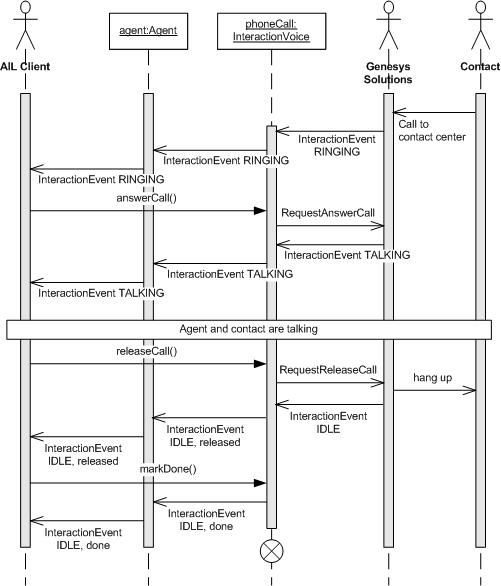Contents
Voice Sequence Diagrams
This appendix presents sequence diagrams for voice interactions.
Make a Phone Call
The first step in making a phone call is to create an interaction of type VOICE. You do this by calling the createInteraction() method on your Agent orPlace interface with the type of interaction. As a result, your application gets an InteractionEvent for a voice interaction in NEW status.
Make the phone call by invoking the makeCall() method on the InteractionVoice interface. At this point, the interaction status becomes DIALING, as specified in the corresponding InteractionEvent. When the connection is established, during the call, the interaction is in TALKING status.
Either you initiate the hang up by calling the releaseCall() method, or the peer has hung up. Either way, you receive an InteractionEvent event of type IDLE.
You finish and clean up the interaction by calling the markDone() method, which releases any reference to the interaction in the library. It also saves the interaction in the history, if you have established a connection between the library and the Contact Server database.
Event flow for making a voice call is shown in Making a Call.
Answer a Phone Call
You have to answer a phone call when you get an InteractionEvent for a voice interaction in RINGING status. To answer the phone call, use the InteractionVoice. answerCall() method. As a result of the ANSWER action, you receive the event indicating that the interaction is in status TALKING.
The end of the interaction is the same as making a phone call: you hang up with InteractionVoice.releaseCall() method and you finish with the InteractionVoice.markDone() method.
The event flow for answering a call is shown below.
Conferencing
A conferencing scenario can be divided into three steps:
- A Contact calls a first agent, named agent1.
-
agent1 initiates a conference with a second agent, named agent2.
-
agent1 creates the conference.
In the first step, agent1 receives a phone call. It is exactly the same scenario as Answer a Phone Call:
- agent1 receives an InteractionEvent event carrying an InteractionVoice interface, named phoneCall1, with the status RINGING.
- agent1 takes the call by invoking the answerCall() method.
In the second step, agent1, already in communication with the contact, invokes the initiateConference() method on the InteractionVoice interface phoneCall1 to prepare the conference with agent2.
After this call, agent1 receives an InteractionEvent event setting the InteractionVoice phoneCall1 to the status HELD. The communication with the contact is paused.
The Agent Interaction Layer creates then two InteractionVoice core objects:
- One for agent1, setting an interaction with agent2. This interaction follows the scenario in Make a Phone Call, and is named phoneCall2.
- The other for agent2, representing his communication first with agent1 and then with the conference. This interaction follows the scenario in Answer a Phone Call and is named phoneCall3.
Next, agent1 receives an InteractionEvent event carrying the newly created InteractionVoice phoneCall2 with the status DIALING. Simultaneously, agent2 receives an InteractionEvent event carrying its InteractionVoice phoneCall3 with the status RINGING. When agent2 answers the call by invoking the answerCall() method, both agents receive an InteractionEvent event showing that their InteractionVoice core objects have the status TALKING. They are now in communication with each other.
In the third step, when the two agents are ready to proceed, agent1 invokes the completeConference() method.
Next, agent1 receives an InteractionEvent event setting the status of the interaction referred by phoneCall2 to IDLE, then this interaction is destroyed.
Finally, agent1 receives two successive InteractionEvent events:
- One resuming the interaction phoneCall1 with the contact, setting it to the status TALKING.
- Another to notify the arrival of a third peer, agent2, on phoneCall1.
Agent2 also receives an InteractionEvent event notifying it of the arrival of a third peer, the contact, on its InteractionVoice phoneCall3.
The conference can now take place, and for each of the agents, each interaction is viewed as a standard phone call and must be ended accordingly.
The event flow is presented in the following two figures.
Transferring a Phone Call
Transferring a phone call follows the same steps as conferencing. Of course, all conference method calls must be replaced here by their transfer counterparts.
The difference lies in the fact that agent1 does not resume its InteractionVoice phoneCall1 at the end of the transfer. That is, instead of setting its first InteractionVoice to the status TALKING after the complete call, it sets it to IDLE and destroys it.
The event flow is presented in following two figures.
Handling a Callback Phone Call
The following diagram shows the event flow for a callback record from a Callback Server in predictive mode.







